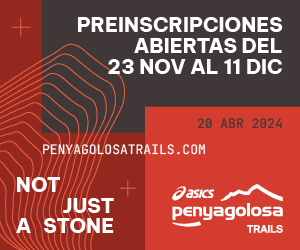 August
22
August
22
Tags
PIKES PEAK MARATHON 2018: FROM COLOMBIA TO AMERICAS MOUNTAIN, IN COLORADO. RACE REPORT BY EMILY SCHMITZ (4TH WOMEN, 4H44M)
.
This past Sunday was the 63rd edition of the Pikes Peak Marathon in Manitou Springs, marking the fourth race of the Golden Trail Series and the only U.S.-based race in the circuit. This iconic American trail race was the first U.S. marathon to allow female competitors, even long before Katherine Switzer slid her way into the 1967 Boston Marathon.
Unlike a traditional marathon, and even most trail races, Pikes Peak is an out-and-back style race, taking runners to a height of 14,115 feet above sea level and back down again to low-lying Manitou Springs. Sunday’s race was a first in many ways: the premier edition of the Golden Trail Series, the first time in 37 years that the women’s record was broken (check out Megan Kimmel), and my own Pikes Peak debut.
__________________________
.
PIKES PEAK MARATHON 2018 PERSONAL REPORT BY EMILY SCHMITZ.
As part of the Golden Trail Series, and the only U.S.-based race, Pikes Peak Marathon soon became part of my 2018 bucket list. Declared the “highest” in the series, I eagerly signed up, but without fully grasping the true meaning of this race’s 14,115 foot summit height. Despite its elevation gain, I was told Pikes Peak was a fast course, due mainly to its runnability, groomed trails, and fast descent. And after almost a decade living abroad in Colombia, Pikes Peak would also be my first trail race in my home country. Trail races are as diverse as the landscapes that shape them, and after running almost solely in South America, I wanted to see the “wild west” of the trail world that only the American landscape and psyche can evoke.
Unlike the plains of the midwest where I grew up, the Coloradan mountain range is expansive and vast; its peaks and valleys tempting me to explore what might lie just beyond. Even after almost a decade of living near the Colombian Andes range, I am still a flatlander at heart, endlessly fascinated by the mountains. Colorado is no exception. With mountainous peaks climbing seemingly out of nowhere into perfectly shaped triangle tips, the Colorado mountains seem to be something from a picture book.

.
Yet I knew this incredible incline–Pikes Peak Marathon has an average grade of 11%–would have its own implications come race day, and it was starting to make me increasingly nervous. Three days before the race, I arrived in Colorado Springs, and immediately headed to the peak to get a feel for 14,115 feet and in hopes of acclimating my lungs. The drive to the summit is winding and steep, and once passing tree line just above 12,000 feet, it becomes desolate and barren, emitting the feeling of driving into the clouds.
At the summit I could feel the pressure of the altitude closing in around me. Lack of oxygen is a multi-dimensional player in endurance running. Its impact seems to change depending on the day, your mood, or what you’ve eaten for breakfast that morning. I felt an overwhelming desire to lay down and sleep for just a few minutes. My lungs, on the other hand, felt surprisingly fine. I continued this routine three days in a row, taking in slightly deeper breaths each time I reached the summit. I tried to imagine what it would feel like on race day when I was here, at the summit, halfway to the finish line.
The night before the race, I carried out my pre-race ritual with perfection, consuming excessive quantities of Gatorade and water, stocking up on fruit and carbohydrates, and spending as much time as possible with my feet elevated above me. At this point, time really starts to slow to a crawl, the anxiety stretching it out in to what feels like eternity. However, I try and let these anxious feelings ride over me, reminding myself to hold on to the desire to run for just one more day. With the pre-race jitters and anxiety, rest can be the enemy. But, I’ve been told the key before a race is to rest just long enough so that all you want to do the next day is run.
By the 7am start of the race, I had checked the weather forecast at least half a dozen times (at 14,000 feet the weather can change quickly and drastically), double and triple checked my shoe laces, and debated obsessively between taking my hydration pack or going free. In the end, I decided to take my pack, a small rain jacket, four gels, and a tiny bottle of Coca-Cola, which I had planned on drinking once I passed the tree line at 12,000 feet, where I calculated I’d need to majority of my fuel.
The course opened down an asphalt road that began to incline slightly until reaching a gravel path alongside the Ruxton Creek. I could already feel my body fighting the slight change in altitude, despite the conservative pace. I tried to remember I had 21 kilometers remaining before reaching the halfway point at the summit, and then heading back down again. A race like Pikes involves a bit of strategy and thought, so that when you hit the summit you still have enough leg power to give you the support necessary for the way down.
As the race progressed, my breathing began to settle into a rhythm. The pack thinned and I found myself at times alone along the path, and other times in the company of a few lone runners. We seemed to be playing a game of tag as we passed through aid stations dotting the trail, until eventually the thick pine covering began to thin out. We had finally reached tree line. From this point on, the lush forest began to give way to rocky debris and red gravel. The path zigzagged across the jagged mountainside and from where I stood, I could suddenly see the top of the summit. High above me, tiny figures dotted the mountainside as the head pack reached the tip of Pikes Peak.
I knew the summit was close now, but the minutes seemed to stretch out longer with each step I took, as the altitude played tricks on my mind. Minutes later I reached the summit, pausing briefly to take it in. It was finally time to switch gears.
The beauty of the Pikes Peak Marathon descent is its incredible runnability, with a slope that allows for speed and agility, and with few technical legs. This rapid descent however, is not altogether free of technical sections, including large rock formations and tree roots that scatter the path. And while the majority curves gently, there are numerous tight and quick directional turns. Out of all the trail races I’ve ever run, Pikes Peak is the first one to have me walking away with stitches. I fell twice along the descending path, both times picking myself back up gently while fighting the urge to acknowledge my discomfort.
I crossed the finish line with a final time of 4 hours 44 minutes in 4th place. Pikes Peak is a beautiful marathon, the race organization and supporters were incredible, welcoming, and have motivated me to come back next year.

_________________________
.
THE GOLDEN TRAIL SERIES: The Golden Trail Series combines five of the most iconic “short-distance” trail races on the planet into a dream tour for both athletes and fans. A €100,000 prize pool will be shared equally among the overall top 10 men & women at a Grand Final at the Otter Trail in South Africa in October. Each of the top 10 will travel with a friend or partner of their choice for the trip of a lifetime to compete for their chosen cause or charity.
GOLDEN TRAIL SERIES WOMENS STANDINGS (after 4 races)

_____________________
.
MEGAN KIMMEL INTERVIEW
.
.
_________________
PIKES PEAK MARATHON : Pictures gallery by Mayayo
_________________
.
MORE ON SKIMO, TRAIL RUNNING AND MOUNTAIN GEAR
- Our best reviews for selected mountain gear.
- Our video collection with athlete´s interviews, races and more.
- Carrerasdemontana.com offers the best trail info in spanish, since 2007.
________________________________
Info by Mayayo Oxígeno for Trailrunningspain


































